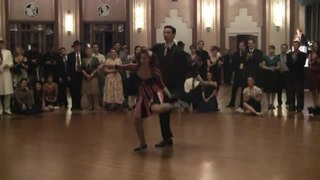| Look up jitterbug in Wiktionary, the free dictionary. |
A jitterbug is a swing dancer, any of various types of swing dances, or the act of dancing to swing music.

The jitterbug is a kind of dance popularized in the United States in the early 20th century, and is associated with various types of swing dances such as the Lindy Hop, jive, and East Coast Swing.
Jitterbug may also refer to:
- "The Jitterbug", a song cut from the Wizard of Oz soundtrack
- Jitterbugs , a film
- Jitterbug Perfume , a novel by Tom Robbins
- Jitterbug Wireless, a mobile phone company
- Diddley bow, a musical instrument
- "Jitterbug", a song by Ellegarden
- "Jitterbuggin'", a song by Heatwave on the album Candles
- "JitterBug", a free software web based (software) bug tracking system
- "Wake Me Up Before You Go-Go", a song by Wham! which uses the spoken-word inserted throughout.
- Jitterbug transformation, a term coined by Buckminster Fuller for the chiral transformations of the Jessen's icosahedron
"The Jitterbug" was a song sung by Dorothy, together with the Scarecrow, Tin Man and Cowardly Lion, that was cut from the soundtrack of the 1939 film The Wizard of Oz. It was both a jazzy development of the plot and a nod to the then-popular bobby-soxer dance craze. As the song begins, the four friends see a jitterbug flitting in the shadows from tree to tree and become frightened. The refrain that they sing is: "Oh, the bats and the bees and the breeze in the trees have a terrible, horrible buzz/But the bats and the bees and the breeze in the trees couldn't do what the Jitterbug does/So, be careful of that rascal/Keep away from The Jitterbug." The Jitterbug puts a magical influence on the characters, forcing them to dance the Jitterbug frenetically. Soon there are many jitterbugs, and eventually, everyone collapses from exhaustion and are subdued by the Witch's army of flying monkeys.

Jitterbugs is a 1943 Laurel and Hardy feature film produced by Sol M. Wurtzel and directed by Mal St.Clair.

Jitterbug Perfume is Tom Robbins' fourth novel and was listed on the New York Times Best Seller list in 1985. It is widely considered a cult classic and one of the "Best books of the 20th century". The book follows two interweaving storylines, one in Ancient Eurasia and one in the present day. Darkly humorous and "presented in an idiosyncratic fictional style", the story connects dueling perfumers in Seattle, Paris and New Orleans to a bottle of incomparable perfume created by two unlikely but defiant lovers of the past who seek immortality. Orchestrated by a mysterious Irish philosopher, the past and the present collide when the characters come together and discover the unexpected path to life-everlasting. The book was first published in 1984 by Bantam Books and later published by Random House.

